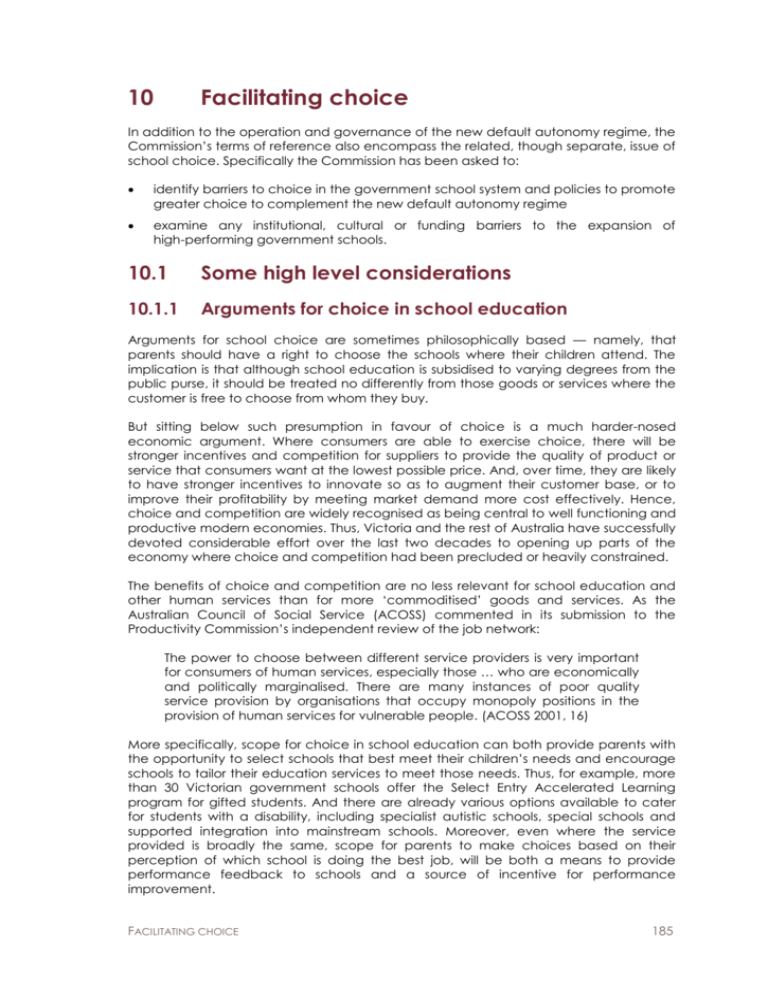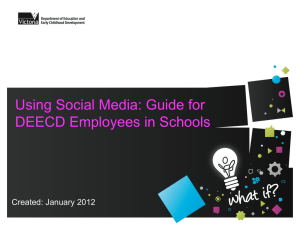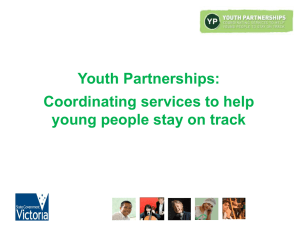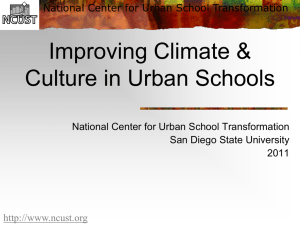Chapter 10 - Facilitating choice
advertisement

10 Facilitating choice In addition to the operation and governance of the new default autonomy regime, the Commission’s terms of reference also encompass the related, though separate, issue of school choice. Specifically the Commission has been asked to: identify barriers to choice in the government school system and policies to promote greater choice to complement the new default autonomy regime examine any institutional, cultural or funding barriers to the expansion of high-performing government schools. 10.1 Some high level considerations 10.1.1 Arguments for choice in school education Arguments for school choice are sometimes philosophically based — namely, that parents should have a right to choose the schools where their children attend. The implication is that although school education is subsidised to varying degrees from the public purse, it should be treated no differently from those goods or services where the customer is free to choose from whom they buy. But sitting below such presumption in favour of choice is a much harder-nosed economic argument. Where consumers are able to exercise choice, there will be stronger incentives and competition for suppliers to provide the quality of product or service that consumers want at the lowest possible price. And, over time, they are likely to have stronger incentives to innovate so as to augment their customer base, or to improve their profitability by meeting market demand more cost effectively. Hence, choice and competition are widely recognised as being central to well functioning and productive modern economies. Thus, Victoria and the rest of Australia have successfully devoted considerable effort over the last two decades to opening up parts of the economy where choice and competition had been precluded or heavily constrained. The benefits of choice and competition are no less relevant for school education and other human services than for more ‘commoditised’ goods and services. As the Australian Council of Social Service (ACOSS) commented in its submission to the Productivity Commission’s independent review of the job network: The power to choose between different service providers is very important for consumers of human services, especially those … who are economically and politically marginalised. There are many instances of poor quality service provision by organisations that occupy monopoly positions in the provision of human services for vulnerable people. (ACOSS 2001, 16) More specifically, scope for choice in school education can both provide parents with the opportunity to select schools that best meet their children’s needs and encourage schools to tailor their education services to meet those needs. Thus, for example, more than 30 Victorian government schools offer the Select Entry Accelerated Learning program for gifted students. And there are already various options available to cater for students with a disability, including specialist autistic schools, special schools and supported integration into mainstream schools. Moreover, even where the service provided is broadly the same, scope for parents to make choices based on their perception of which school is doing the best job, will be both a means to provide performance feedback to schools and a source of incentive for performance improvement. FACILITATING CHOICE 185 10.1.2 The impacts of choice on access and equity While choice has a potentially important role to play in the schools sector, this is not to suggest that unfettered or ‘unsupported’ choice would be appropriate. Like other human services, school education has some distinguishing features that: may constrain the degree of choice that is desirable or at least make it incumbent on governments and policy makers to ensure that other policy settings are such that the benefits of choice are not negated by unwanted effects. Of particular relevance here are the access and equity objectives that attach to school education. The capacity to access a quality school education underpins the lifelong economic and social well-being of individuals and to a cohesive and productive society more generally. Reflecting this, the right of all children to access quality school services is a foundation stone for school policy in most countries and is encompassed in various international charters. For the most part, including in Victoria, this universal access goal has been pursued through government provision of free, or heavily subsidised, school services. In this environment it is important to consider how choice in the government school sector — or between government and non-government schools (see below) — may affect access rights. The concern expressed by some is that choice exacerbates inequality, and the fact that others argue for the benefits of choice make this a contested issue. 10.1.3 The evidence on school choice Different political groups use evidence that supports their positions in favour or against school choice, and their positions relative to school choice are largely based on their ideologies, rather than on empirical work and evidence of effectiveness. (Levin and Belfield 2004; in Musset 2012, 4). The Australian Education Union (AEU) submission points to a recent Organisation for Economic Co-operation and Development (OECD) working paper (Musset 2012) that attempts to step away from the ideological debate by systematically examining the evidence on the impact of choice on disadvantaged students and schools. The study concludes that while choice can enhance opportunities for some advantaged parents and students with strong achievement orientation, it also harms others, often more disadvantaged and low socioeconomic (SES) families (Musset 2012, 43). The paper concludes, however, that the negative impacts are not an inevitable consequence of choice, but careful design of school choice schemes can allow school systems to combine parental freedom and enhanced opportunities for disadvantaged children. Notably this same emphasis also underpins the Gonski review, which in putting forward a new school funding model designed to better match school resourcing to student needs, refers to the value of choice to many parents and to previous OECD research pointing to the scope for choice to enhance academic outcomes (Gonski et al. 2011, 12–13). The London School of Economics Growth Commission came to similar conclusions but went further to find that choice is affected by autonomy: There is evidence that more autonomous schools respond better to local parental choice, so increasing parental choice will not lead to higher standards without greater decentralisation to empower head teachers. (LSE Growth Commission 2013, 17) 186 MAKING THE GRADE: AUTONOMY AND ACCOUNTABILITY IN VICTORIAN SCHOOLS 10.1.4 The Commission’s view The Commission considers that choice and autonomy are separate concepts. But as both autonomous decision making and choice typically exist side by side, their effects can be intertwined and reinforcing. For example, where there is scope for choice, schools that take best advantage of the opportunities provided by greater autonomy to improve their services are likely to experience increased demand. At the same time, without appropriate funding arrangements, choice can magnify the risks of greater autonomy for disadvantaged students and vice versa (chapter 11). The Commission considers the risk of choice to equity outcomes can be greatly reduced by providing schools that cater for heavy concentrations of educationally disadvantaged students with appropriate funding, quality leadership and teaching resources, and effective governance frameworks. Thus, residualisation concerns are an argument for a holistic and careful policy approach, not for forgoing the benefits that choice can bring. 10.2 Choice between systems As indicated above, the terms of reference focus on barriers to choice within the government school system. But the government system exists along-side a less-subsidised Catholic school system and a significant number of differently subsidised independent non-government schools. Provision of choice in the government system must have regard to the consequences of choice between systems. The OECD has concluded that education systems where choice is provided to some and not others are inherently unfair, especially when SES status determines opportunities (Musset 2012). Conversely, the OECD argues that removing barriers to choice can improve equity as parental income and education becomes less important in determining access to high quality education. Since the option of school choice through residential mobility 1 or through enrolment in private schools has always been available to wealthy families, school choice programmes can allow [school systems] to expand this right to every student. (Musset 2012, 43) The continued drift of students to non-government schools (chapter 2), illustrates that enhancing competitiveness through the range of quality choices is also critical to the long-term success of the government school system. Arguably, restraining choice within the government system — even if well-motivated by a concern to avoid residualisation — will simply accelerate student drift to the non-government sector. Indeed, as noted in chapter 2, government schools are already doing the bulk of heavy lifting in regard to the education of disadvantaged students. The key therefore, is to manage choice in the government sector (and across sectors) appropriately, including through a funding regime that minimises the risks of adverse impacts. The Commission further notes that some elements of the difference between government and non-government schools are becoming, or may become, less distinct: 1 As the level of school autonomy increases, government schools have access to more of the flexibilities available to non-government schools. Residential mobility is discussed in chapter 12. FACILITATING CHOICE 187 The sort of funding model proposed by the Gonski review would see the taxpayer meeting a very high proportion of the recurrent costs of non-government schools catering mainly for low SES students — with non-government schools serving students or communities with very high needs potentially fully funded from the public purse. That said, there can be other important distinctions between government and non-government schools, or among non-government schools around such issues as educational philosophies and religious beliefs. The discussion below of barriers to choice and the expansion of high performing schools relates to the government school system. The discussion in chapter 11, however, of the implications of school autonomy and choice for disadvantaged students approaches choice from a sector-wide rather than within-system perspective. 10.3 Barriers to greater and/or more effective choice in government schools There is already some choice in Victoria’s government school sector. The previously mentioned specialisation options, such as select entry schools and those catering exclusively for children with special needs, is one dimension of this choice. As mentioned in section 10.5.1 around 85 per cent of government schools do not restrict enrolments, offering significant scope for choice in many areas. In thinking about barriers to choice in the government school sector, it is helpful to delineate between factors that may: limit the efficiency of parents’ choices over available offerings constrain the range of service offerings open to parents. The range of educational offerings available in the government sector will most broadly depend on access to funding and specialised resources. And it may also be influenced by system-wide constraints on how schools can configure and deploy their workforces. However, these issues have a much broader relevance to the inquiry and are discussed in various contexts elsewhere in the report and especially in chapter 8. More specifically, notwithstanding the degree of specialisation that has emerged in the government school sector, its extent may have been constrained by lack of flexibility in curriculum requirements and workforce shortages in particular areas (for example, maths and science teachers). The prospective reforms to the current Victorian Essential Learning Standards (VELS) are intended to address such inflexibilities and, in conjunction with the introduction of default school autonomy, will give schools greater scope to differentiate their learning offerings. The Government has further signalled that there will be scope in future for schools to offer a Victorian Baccalaureate, Industry Pathway Programs, and other specialist senior secondary programs (DEECD 2012a, 14). In light of these developments, the Commission does not envisage significant specialisation barriers to choice in the government school system in coming years. Accordingly, the discussion in the next section focuses on factors that may impede parents choosing between the school offerings that are available, or detract from the efficacy of the choices they make. Section 10.5 also examines barriers to expanding high performing schools as a means of increasing the range of choice available. 188 MAKING THE GRADE: AUTONOMY AND ACCOUNTABILITY IN VICTORIAN SCHOOLS 10.4 Information issues The capacity for parents to exercise choice, and more particularly to make effective choices, requires them to have appropriate information on what schools are offering and how well they are performing. While the former has not usually been an issue, until recently, the information on school performance available to parents was often limited. Courtesy of a range of State and national performance reporting initiatives, parents now have access to more school performance data than in the past. Of particular relevance in this context is the capacity to compare the National Assessment Program – Literacy and Numeracy (NAPLAN) student test data across schools with similar demographic characteristics, which is published on the My School website operated by the Australian Curriculum, Assessment and Reporting Authority (ACARA). As well as raw student scores for literacy and numeracy, those scores can be compared to other schools with similar SES student cohorts. Improvements in literacy and numeracy over time can also be compared across schools (again stratified on the basis of SES and starting literacy and numeracy scores). Comparative student performance data is one factor that influences parents’ choices. School location, social networks, the school environment, the range of extra-curricular activities on offer and (in the case of non-government schools) the religious dimension will, to varying extents, also influence parents’ decisions. Nonetheless, the clear policy intention is that comparative student performance data become a more important influence on parental school choice in the future. It is therefore important that efforts to further enhance the available data, and thereby promote effective parental choice, continue. Consistent with this, the Commission is proposing that the Victorian Government supplement the My School data by making its currently internal data on school ‘gain scores’ publicly available (draft recommendation 6.3). In support of a more autonomous school system the Commission is also recommending the introduction of a common ‘balanced scorecard’ performance reporting system for all government schools (draft recommendation 6.3). As well as educational performance this scorecard would provide information on the school’s performance in areas such as student, parent and community engagement, and school and teacher development. In addition, there is a role for the Government and bodies like ACARA to promote more focus on value add in media reporting of student performance. As the emphasis that some schools place on media marketing indicates, the role of the media in influencing parental choice should not be underplayed. At present, such reporting focuses very heavily on raw student scores and thus presents a potentially skewed picture of how schools are actually performing. 10.5 Barriers to high performing government schools expanding Some high performing schools are at capacity and would grow, but face barriers to expansion, and as discussed these barriers are not insignificant. Addressing the issue of the skewed picture of school performance the Victorian Association of Secondary Schools Principals (VASSP) questioned how high performing school should be defined. Are they schools that attract a high proportion of high performing students? Or are they schools that ensure significant gains in student achievement regardless of their starting point (VASSP sub. 7, p.9)? The Department of Education and Early Childhood Development (DEECD) has indicated the importance of relative performance, that is FACILITATING CHOICE 189 that schools can reach capacity as a result of parents either perceiving a school is high performing or avoiding a school they perceive is low performing. As noted above, improved information on gain scores may help parents make better choices. More efficient decision making could alleviate the pressure on some schools currently perceived as high performing where gain is low. It could also increase demand for schools currently perceived as low performing where gain is high. With improved gain score information the constraints are more likely to match school performance than perceptions. Where excess demand is caused by parents avoiding a school because of real rather than perceived quality issues, this could be alleviated through improved principal and teacher performance (chapters 6, 7, and 8). Indeed, transforming middle performing schools to high performing ones and leveraging performance improvement across groups of schools are likely to drive the biggest benefits. And these gains are essential to achieving the goal of Victoria becoming a top tier education system. While the draft proposals in chapters 6 to 9 will help to improve the range of choice and the efficiency of decision making, there will continue to be a residual of capacity constrained high performing schools. Addressing barriers to these schools expanding involves improving how caps and zones are implemented, increasing use of multicampus schools and underused assets, and, in limited circumstances, investing in infrastructure. 10.5.1 Improving how caps and zones are implemented A longstanding policy in Victoria and other jurisdictions is that children are guaranteed enrolment at their designated neighbourhood government school (Education and Training Reform Act 2006 (Vic) s 2.2.13). Amongst other things, this requirement promotes the access objective by obviating the need for less affluent parents, or those facing other substantial education related costs, to spend significant sums and/or time on school transport. Exceptions in the Act, however, allow the Minister or delegate to apply enrolment caps and/ or school zones and while most schools offer unconstrained access the barriers to perceived high performing schools expanding are not insignificant in Victoria. Caps and/or zones apply to around 230 (15 per cent) of schools catering for around 145 000 (20 per cent) of students and of these, two thirds are primary schools and one third secondary schools (DEECD 2013m; DEECD 2013a). Consolidated data on ‘out of area’ enrolment (and especially on the students schools decline to enrol) would provide a clearer picture of constraints on choices but DEECD does not collect this type of data. Suffice to say, choices are constrained but better information would help to better manage excess demand for high-performing schools. For schools that are in high demand, guaranteed enrolment for students within the designated local area may limit choices for parents and students living outside the catchment concerned.2 This might in turn lessen the ‘demand-driven’ incentives for performance improvement across the system. To the extent that improved data on declined and enrolled students provide insights on SES and academic performance, it could help inform and manage inequality and access outcomes that have arisen in New Zealand and the United Kingdom. Along with the recommendations in chapter 11, removing the barriers to high-performing government schools (section 10.5.2) would 2 Property prices have been shown to increase in the zones around some high-performing schools and this tends to exclude students from lower socioeconomic cohorts (Gibbons 2013; Davidoff and Leigh 2008). 190 MAKING THE GRADE: AUTONOMY AND ACCOUNTABILITY IN VICTORIAN SCHOOLS also help. At any rate, the location and significance of constraints are likely to change as autonomy increases and performance improves, increasing the premium on information on capacity constraints. Even with existing information the extent of caps and zones indicates the constraints on choice are not insignificant and there is evidence that DEECD could improve how caps and zones are implemented. DEECD indicated that in 2011 seven out of nine school regional offices were dealing with contentious issues related to neighbourhood areas. These included: zones for high schools based on primary schools that no longer exist, meaning students may need to travel long distances to a high school regions insensitively applying caps and zones significant use of zoning in some high growth regions. The Commission understands that DEECD is aware of these problems and has plans in place to improve implementation. 10.5.2 Increasing use of multi-campus schools and underused assets Multi-campus schools are made up of principals at more than one campus reporting to an executive principal. There is already experience with the operation of multi-campus schools but the current system is dominated by one campus, one principal schools. Increased use of multi-campus schools could allow high-performing schools to expand and increase the efficiency of infrastructure use. Increasing the size of single campus schools results in diseconomies of scale at some stage, creating a natural constraint on expanding the role of high-performing principals. And while many high-performing schools lack capacity to expand ‘there is considerable surplus of building space across the [education] portfolio – 38 per cent according to current enrolment levels’ (VAGO 2013). There is significant scope to expand multi-campus schooling, as evidenced in the UK where there are 91 chains with an average of 3.2 schools each.3 Principals of high-performing schools could expand their sphere of influence through multi-campus arrangements, improving the mentoring of campus principals, and therefore improving teacher quality. Multi-campus schools could increase choice through school specialisation and improve efficiency through economies of scale and scope. A multi-campus arrangement could pair a school with underutilised infrastructure with an at-capacity high-performing school, providing an outlet for growth of the high-performing school. As mentioned in chapter 6 the education systems needs a driver for principal co-operation and multi-campus arrangements provide a natural incentive and reduce barriers to such cooperation. The network-level governance discussed in chapter 9 would be helpful in facilitating collaboration across schools, and in particular allowing tailoring of collaboration to suit individual circumstances. 3 Academy chains are not exact parallels to multi-campus schools but some share significant similarities. These chains take many forms and many are informal collaborations between two schools that may involve only ‘light touch’ collaboration. Some are groups of schools with the same sponsor, more akin to multi-campus schools with executive principals (Academies Commission 2013, 17). FACILITATING CHOICE 191 The potential for multi-campus schools would be subject to some constraints. These include practical limits to the span of the executive principal’s control such as school size, the number of schools and geographic spread. Parents may also resist having their principal’s attention diluted if they move into an executive principal position. Accountability would also be more important for multi-campus schools, as the consequences of underperformance are greater. Notwithstanding these constraints, the Commission considers an increase in multi-campus arrangements could allow for increased efficiency and allow high-performing schools to expand, therefore improving outcomes and reducing costs. 10.5.3 Infrastructure investment There may be some opportunities to remove barriers to expanding high-performing schools on a single site by expanding infrastructure but, given the cost, a cautious approach is important. Building infrastructure is expensive, especially relative to multi-campus arrangements, and because school infrastructure is long lived, investments must give heavy weight to longer-term enrolment trends. But that does not mean infrastructure investment should be ruled out. In many markets, businesses balance investing where demand is greatest, increasing use of underutilised infrastructure, and selling significantly underutilised assets. There are examples of this approach being successfully used in the Victorian government school sector (box 10.1). To the extent that DEECD’s capital works planning has been a constraint on the ability of schools to expand, the new infrastructure and asset management model foreshadowed by Towards Victoria as a Learning Community should alleviate this. Specifically, it is expected to: provide more transparency around capital funding; increase certainty about infrastructure planning and investment; and reduce red tape for schools. Over the longer term it may be possible to devolve some of the infrastructure and capital planning responsibilities. This could create greater flexibility and improve responsiveness of infrastructure investment to demand for high-performing schools. Box 10.1 Broadmeadows School Regeneration Project Among other things, the Broadmeadows School Regeneration Project merged and shut down small schools that were old and expensive to maintain, replacing them with new facilities at the same time as providing cost efficiency for government. Commencing in 2003-04 and continuing until 2011, the primary aim of the project was to significantly improve the literacy and numeracy outcomes of students attending schools in the area. The project also aimed to improve retention rates to Year 12, provide a wider range of curriculum pathways for senior students, improve the perception of Broadmeadows’ schools, and build modern facilities for community use. A major part of the project involved reviewing and reforming the curriculum and teaching and learning practice in all schools to meet the contemporary learning needs of students. To improve classroom practice and build capacity at the school level, the Achievement Improvement Zones program was introduced by the Northern Metropolitan Region in 2008. The areas of focus were school improvement, data, behaviour, literacy and numeracy and coaching. Each area is led by an educational expert. 192 MAKING THE GRADE: AUTONOMY AND ACCOUNTABILITY IN VICTORIAN SCHOOLS Box 10.1 Broadmeadows School Regeneration Project (cont.) Construction of new school buildings occurred simultaneously with the updated curriculum development. It involved merging 17 schools (secondary, primary and special schools) into 10 schools. The savings associated with the mergers allowed for construction of seven new school buildings. Source: DEECD 2010a, 3; DEECD 2006, 3. 10.6 Conclusion The Commission considers that improving choice and competition can create more efficient incentives for schools to improve performance. Indeed, without such improvements the drift in students, particularly high-performing students, to the non-government school sector is likely to continue, exacerbating the pressure on government schools. The way improved choice and competition are implemented is critical to ensuring the efficiency and quality benefits are achieved and the equity and access outcomes are maintained and/or improved. Many of the options to improve choice and competition are subject to draft recommendations in previous chapters: improving low performing schools to enhance the range of choice available supporting more efficient school choice by publishing improved information on student performance increasing the use of multi-campus schools through improved incentives for collaboration and allowing for multi-school boards. The recommendation unique to this chapter is improving information on out of area enrolments. Draft recommendation 10.1 That, to improve the understanding and management of barriers to choice, the Department of Education and Early Childhood Development (DEECD) require schools to collect information on the place of residence of students accepted and not accepted to schools. That DEECD publish this information in a manner that allows for simple comparison across individual government schools. FACILITATING CHOICE 193







